Wayanad: The Land of Paddy Fields
Located in the Western Ghats in northern Kerala at an elevation of 3,000 feet, Wayanad is home to one-third of the total tribal population (1,51,443) of Kerala—4,84,839, as per 2011 census. The district, with a forest coverage of 83 per cent of its total geographic area, is rich in flora and fauna, and has been considered a biodiversity hotspot of Kerala.
The name Wayanad is said to have been derived from the Malayalam word vayal, meaning paddy field, and naadu, meaning land, and this, over time, became Wayanad. There are also other beliefs about how the name Wayanad has been derived. One popular suggestion is that it is taken from the word ‘Vana-naadu’, meaning ‘forest country’. Another less popular belief connects it to ‘Mayanadu’, the land of Mayan, the mythical character who built the capital of Indraprastha for the Pandavas, given the probability of interchanging ‘ma’ and ‘va’ in Malayalam. However, the most widely accepted etymological source is Vayal Nadu.
Until the arrival of settler peasantry from other parts of Kerala in the early nineteenth century, Wayanad was essentially home to the tribal population of Kerala. However, today these tribes form only 16 per cent of the total population of the district. Wayanad, until the mid-twentieth century, was the land of paddy fields and known for its cash crops. Today, coffee, tea and pepper form the major crops in the district. Of all the adivasi communities in Wayanad, the largest population is that of the Paniya tribe, also known as Paniyar/Paniyan, recognised as a Scheduled Tribe. (Fig. 1)

The Origin of the Paniya Tribe
The Paniya tribe is found in Wayanad, Kannur, Kozhikode and Malappuram districts of Kerala, and adjoining districts of Coorg in Karnataka and the Nilgiris in Tamil Nadu. Majority of the entire Paniya population of South India inhabit in Wayanad. According to the Census of 2011, there are 15,876 families of Paniya in Wayanad, contributing to a population of 69,116.
The term Paniya/Paniyan/Paniyar essentially means ‘someone who does work’ or ‘labourer’. In all likelihood, this name also suggests their social standing, as a community who does work for their landlords. Historically, Paniyas have been agrestic slaves who worked in the agricultural field of the janmis or landlords.
There are multiple legends and folklore associated with the origins of the Paniyas. They themselves suggest that they come from a place called Ippimala, a hilltop, where there lived only two individuals, a man and a woman. They believe that they were brother and sister above their torso, and below the torso, different individuals. The Paniyas believe that they are descendants of this couple from Ippimala. This couple, known as Ippimala Muttasi and Ippimala Mutappe in local language, is revered by the Paniya. No evidence to support this tale have been found, and hence the story remains a part of the legend.
Another suggestion about the origin of the Paniyas came from Edgar Thurston, a British administrator who documented the ethnography of people of South India in the early part of twentieth century. He suggested that the Paniyas have similar racial features to that of Africans. The theory suggested that they were shipwrecked on the Malabar coast. Another theory also suggests that the Paniyas were brought as workers to Wayanad by a king in Malabar. However, both these theories have been discarded due to lack of evidence to verify these claims.
Occupation
Though the origin of the community is largely debatable, it is true that the community of Paniyas served local landlords as agricultural labourers. This type of labour provided by the Paniyas for the janmis is known as kundalpani or bonded labour. The buying and selling of these agrestic slaves used to happen at an annual temple festival at Valliyurkaavu, in Mananthavady, Wayanad. The goddess at Valliyurkaavu is also worshipped by the Paniyas and other tribal communities of Wayanad, such as the Adiyas, thus ensuring religious sanction. From among the Paniyas who assembled at the temple festival, the janmis bought labourers at a price the former believed to be fair—an amount of 10 or 30 INR was given to the chosen labourer, and he was bound to work for the same janmi at a meagre wage. A Paniya was required to pledge the members of his family against a money loan (the initial payment made by the landlord to the Paniya labourer), and until he cleared the debt, the members of his family were bound to work for the janmi from whom loan was taken. The Paniyas believed that the wrath of the goddess will fall on the one who dared to break the contract with their master, and hence, they accepted this arrangement without protest.
These landlords, while they may have treated Paniyas as slaves, also used to engage with them during festivals, such as during the Malayalam New Year, Vishu, which falls in the month of April, by making contributions and gifts. During this time, the janmis gave a certain quantity of paddy to their Paniya servant, the acceptance of which meant the labourer could not leave the master that year. The janmis also gave the women new clothes for festive occasions as a mark of charity.
This system of bonded labour came to an end in 1975 with the abolition of the same by the Kerala state government. Today, though the Paniyas still work in the fields of landed farmers, they are wage labourers working on agricultural fields of landholding farmers near their tribal colonies. (Fig. 2) The men get paid about 600 INR for the work they do, while the women only get 350 INR. In addition to being agricultural labourers, they also have the option of being part of the Mahatma Gandhi National Rural Employment Guarantee programme, where an individual in a household gets employment for 100 days or more, or taking up odd jobs for the village community nearby. The Paniya women work as maidservants in the houses of farmers living close to their tribal colonies.
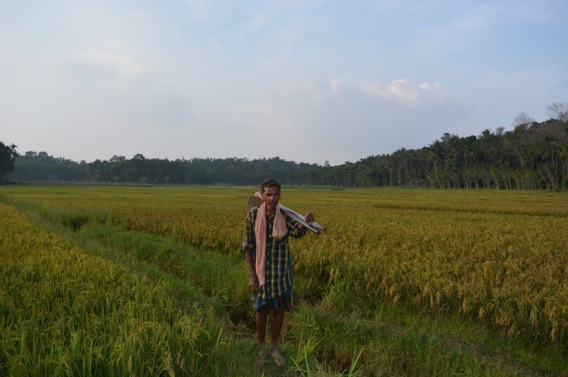
Fishing is yet another activity the Paniyas engage in, mainly during the monsoons, when the waters overflow in the canals and river nearby. (Fig. 3) However, fishing is more a source of leisure; the fish that they catch is for consumption in their household.
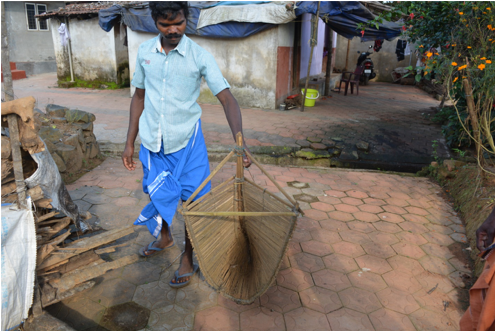
Settlement
A Paniya’s house is called pire or kudumbu. Traditionally the hut, or kudumbu, used to have walls made of mud and bamboo, and the roof was either made of bamboo or hay. A colony of Paniya houses is called a paadi, and many of these together form a karumam or a village.

Today, such houses are rare as most Paniya families in Wayanad inhabit concrete houses in colonies built by the government. (Fig. 4) Most of these houses have a small courtyard, a kitchen, a bedroom, and a toilet built outside the house. The government does not demand any money from them for building these houses, but in turn expects their labour in helping build the house. These houses now flaunt television sets and youngsters with mobile phones—the lines between an ordinary household in rural Kerala and a household in a tribal colony are being blurred.
Apparel and Accoutrements
With changes that have come about in their living conditions, the old ornaments and clothing that the Paniyas wear have also become difficult to locate. A few elders still use them, but it is no more worn by the younger generation. People who are skilled in making Paniya ornaments also are not found in the district.
Earrings, known as oolay, is very typical of the community. (Fig. 5) Another type of earring has lucky red seeds (Adenanthera pavonina), known as manjadikuru in Malayalam, stuck inside a ring of coconut palm leaf using beeswax or gum from jackfruit tree. The ear is pierced to fit the size of the ring or ooda. This particular kind of earring is called a choonthumani. (Fig. 6)
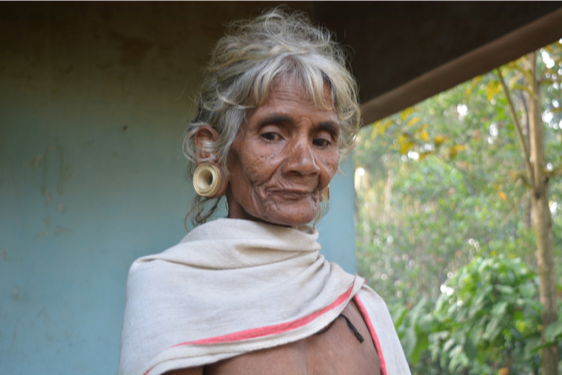

The Paniya women also wear neckpieces made of beads of various colours. These neckpieces, ballikkale and panathaali, are of specific lengths. The panathaali is a sacred jewellery that is worn only on auspicious occasions by women. Holes are made on the coins that the Paniya women receive for their labour, and these are strung together along with beads and worn as a neckpiece. The number of coins on the neckpiece suggest the amount of work that they did; the more the number, the more the work they have done. Mudechoolu is yet another type of neckpiece worn by the Paniya tribes. Today, there are not many women who wear these traditional jewelleries, except one or two of the oldest. Some even have resorted to wearing modern jewellery, mostly bought from fancy stores in the town.
Folk Performances of the Paniya Tribes and their Instruments
There are two main traditional ceremonial performances associated with Paniya culture—Vattakali and Kambalakali. Other than these, there is also Maaritheyyam, a ritual performance in which a person, usually a man, is worshipped by the people around him while he takes on the form of ‘theyyam’, an embodiment of the goddess he is paying respects to.
Vattakali, a form of dance performance, literally means a performance in a circle. As the name suggests, this is performed by women who form a circle and dance rhythmically to the sound of the thudi (a small, drum-like instrument resembling a damru) played by three men. The performance is usually accompanied with singing by the women, and the songs usually are sung to tease one of the women dancing with them, or one of the men playing the instrument.
Kambalakkali is the performance associated with Kambalanatty, the paddy replanting ritual. Kambalakkali was performed on the paddy fields of the janmis, where the women engaged in planting paddy to the rhythm of thudi and cheeni (a pipe-like instrument). Kambalakkali is not performed as a ritual anymore, as the system of bonded labour has ended and the Paniyas no longer work as agricultural labourers in many cases. However, recently, in October 2018, this practice was recreated in the paddy field, with about hundreds of Paniya labourers gathered in the field, planting paddy.
Today, Vattakali and Kambalakali are performed on stage or in special settings meant to promote tribal art performances.
Musical instruments
Thudi: This musical instrument is an integral part of the Paniya tribe, and is a part of all their folk performances. (Fig. 7) While the wooden portion of the thudi is made of a jackfruit tree’s trunk, the skin for the drum is made of goat skin. Earlier, they were made using the skin of monkeys and wild goats. There are various forms of playing the thudi; each being specific to a particular event.
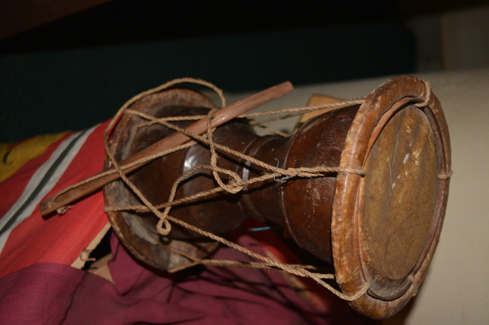
Cheeni: Cheeni is another important instrument belonging to the community. (Fig. 8) It is also known as peeki or kuzhal. The instrument has three parts—a long pipe with air-columns in the middle, a bowl-like part at the top, and a vase-like part at the bottom. These three parts are assembled together while playing the cheeni. Each part is made of different kinds of wood. Also, there are different types of cheenis, some are just a single straight pipe.
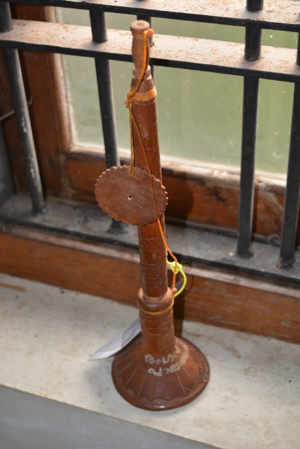
Social Structure of the Paniya People in the Past
Previously, the Paniya community was divided into various clans or illams, such as Narikokkoden, Maniyangoden, Choladiyan, etc. The headman of the clan was called the chemmikkaren or chemmi or kuttan. The Chemmi had an integral role to play in the lives of the Paniya people, as they were required to be present for most, if not all, customs and ceremonies, and they also had the authority to decide punishments for offences committed within the community. Usually, the headman was chosen by the landlord on whose field the Paniyas used to work, and served as a mediator between the landlord and the rest of the community.
Today, such a social structure does not exist within the community, and most in the community are aware of the laws and rights provided to them by the government. For settling matters of dispute, they now approach the local police officials.
Traditionally, within the Paniya community, men and women are treated equal. Earlier in the fields of the janmis they used to labour together, and eat together in their living quarters. Keeping in tandem with this tradition, women enjoy a relatively equal status in the community today.
Customs and Rituals Related to Marriage and Death
Marriage: Linguists like P. Somasekharan Nair, who have studied the community in the late 1970s, suggest that the Paniyas practise endogamy, and are monogamous. The decision to get a girl and a boy engaged in marriage is done with the approval of the headman. Among the Paniyas, the prospective groom is supposed to pay a price to the family of the bride, or the bride in some cases, before the wedding. In case he is unable to pay the price, he can be of service in any other way to the parents of the bride. In addition to this, there is also the idea of giving presents to the family of the bride, especially to her mother, and it is an important tradition of a Paniya wedding, and the inability to do so resulting in, in many cases, the bride being taken back to her parents’ house. The wedding ceremony usually takes place in the evening, at the house of the bride, which includes Vattakali performances as well. Even today, the wedding ceremony of the Paniays is as elaborate an affair as it was in the past, which involves the coming together of village people from around the colonies.
Death and burial: A deceased person is buried by the Paniyas. The seventh day following the death involves a ceremonial dancing and singing performance at the grave. The close family members of the deceased also maintain abstinence till the sixteenth day after death of an individual, during which they avoid consuming meat or fish. However, today, the traditional practices are gradually being replaced by locally standardised Hindu practices.
Paniya Language
The Paniya dialect, or Paniyabhasha, is a mixture of Malayalam, Tamil and Tulu. To communicate among themselves, they still use this language; to outsiders, they speak in fluent Malayalam. The young generation today can read and write in Malayalam and communicate with each other in Malayalam, using Paniyabhasha only to talk to elders.
Embracing a Modern Life
From having been bonded, landless labourers, the Paniya tribe has seen many changes with time. The younger generation responds positively to social changes. Children attend schools; girls attend school with boys, and engage with education as much as the boys do. They have higher aspiration level compared to the previous generation. While this remains as a sign of progress, there are a lot of school drop-outs among them—a matter of grave concern amongst local self-governments (Panchayats), school authorities and tribal development departments. However, the fact remains that the Paniya people form the most deprived segment of the population of Wayanad, and majority of them are still landless. Though welfare measures have been provided, they have not yielded the intended results.
Bibliography
Damodaran, Nettoor P. Aadivasikalude Keralam. Kottayam: National Book Stall, 1964.
Luiz, A.A.D. Tribes of Kerala. New Delhi: Bharatiya Adimjati Sevak Sangh, 1957.
Mathur, P.R.G. Tribal Situation in Kerala. Trivandrum: St. Joseph’s Press, 1977.
Nair, C. Gopalan. Wynad, the People and its Traditions. Madras: Higginbothams & Co., 1911.
Nair, P. Somasekharan. Paniyan. Kottayam: National Book Stall, 1976.
Pradeep, K.S. ed. Rhythm of Tribe. Kozhikode: KIRTADS, 2017.
Singh, K. S. The Scheduled Tribes. New Delhi: Anthropological Survey of India with Oxford University Press, 1994.
Thurston, Edgar, and K Rangachari. Castes and tribes of Southern India. New Delhi: Asian Educational Services, 2001.

